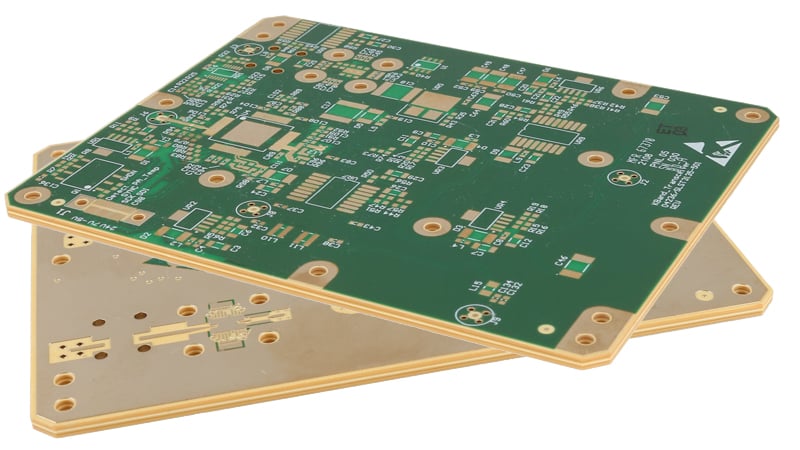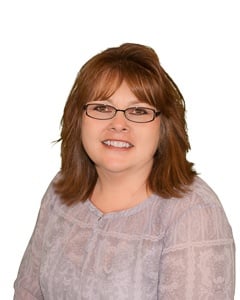Not all printed circuit board (PCB) materials are created equal. In fact, to say there is an equivalent for any is untrue. Although, they are all in line with each other for basic attributes and are close but not exact. These many different flavors are also not always available; some come with a steep cost, a high Minimum Order Quantity (MOQ,) and a long lead time.

Printed circuit board with FR4 laminate (top) and PTFE laminate (bottom).
So, what do you need to know about all items related to printed circuit board materials? In this post we will review the differences between some of these material types along with and the cost and performance of each type.
FR4 Laminate
Standard PCB laminate material is known as FR4. It’s the main staple and most commonly used type of material used in printed circuit board manufacturing and has a wide variety of manufacturers. What used to be a somewhat of a one flavor 130Tg laminate made by several suppliers such as Isola, TU, Nanya, and ITEQ, with the RoHS compliance and getting the lead out of processing a higher temperature material was needed to withstand assembly processing. During assembly of some types of PCBs, there are multiple weave soldering trips, reworking, and hand soldering proved 130Tg would not hold up to the heat.
It was determined fairly quickly that a stronger weave and better performing laminate were needed by the industry suppliers to withstand processing next to the market 170Tg and 180Tg materials yet still FR4 base to take the heat of assembly. With these higher Tg materials, there is a higher cost associated to purchase, although the processing is the same, they do cost more to produce. Standard FR4 temperature laminates are widely used for all types of PCBs from the simplest 1-layer to the most complex multilayer circuit board designs.
Because FR4 is so widely used and standardized thicknesses, such as 0.031”, 0.062”, 0.093”, and 0.125” for example, it is easy to stock a variety of thickness to produce many parts for many different customers at one time. For multilayer PCBs, the commonality of cores, 0.005”, 0.007”, 0.010”, 0.014”, and so on also allows for stocking the commons to be used.
Using common thicknesses and buying in volume aids in keeping costs lower for most scenarios as well as making it easier to buy larger volumes because the laminates are common.
PTFE Laminate
PTFE or polytetrafluoroethylene is a synthetic thermoplastic fluoropolymer and is the second most commonly used PCB laminate material. It offers consistent dielectric properties at a higher coefficient expansion than standard FR4. These two laminates, FR4 and PTFE, quickly became the 2 options for all PCBs coming to the market.
The PTFE is commonly used in higher-speed, higher-frequency technology. One example is microwave technology: the PTFE has a higher coefficient of thermal expansion (CTE). This makes it a good choice where the PCB could see changes in temperature.
The base PTFE had its challenges to overcome with the addition of woven glass assisted in the stability or size changes of the laminate due to fluctuating temperature. Later, ceramic fillers and microfiber glass were introduced to increase the dielectric constant (Dk) values. PTFE with additives such as glass or ceramic improved and stabilize the DK, allowing for a better signal between parts to be had.
The additional cost for this type of material is significant from FR4. It is more costly to produce and typically the quantity of PCBs is smaller for the purchase. This, compiled with the part’s physical size, is also typically smaller in the X,Y, driving up the cost to manufacture.
The supplier imposes an MOQ on laminate purchases to multiple sheets, leaving stock on the shelf for an undetermined amount of time. This cost is passed on to the consumer in the piece price or laminate cost to encourage consumption and ease the pain of purchasing and having stock for long periods of time. Introducing multiple parts on one panel has become more common to aid the customer in keeping costs down; we have seen 8 or 12 different PCBs on a single array for a one-time buy versus buying 5 pieces of 8 or 12 different parts in a single purchase each. This saves the customer on NRE passing as 1 instead of 8 or 12, but it also assists production on the consumption of panels where the physical size is small, so it is allowed.
Who are the Material Suppliers and What Do I Need to Know?
The suppliers of specialty materials such as PTFE-ceramic, high Tg, and polyimides have been some of the same since the production of PCBs began. Rogers, Arlon, Taconic, and Isola all have their specific knitch, and in most cases, you can download the material data sheet in PDF format for free. During the PCB design phase, reviewing the attributes in the datasheet is advantageous to your circuit board functionality, however, the selection of material based on what you find is not always available at your fabricator.
Consulting your PCB supplier on selection(s), stack-ups, and materials. In some instances, your product may require a UL applied to the PCB; many suppliers do not carry a UL for specialty materials due to the high cost to UL and low volume or purchases for the material. Depending on your choice, there could be availability, additional cost, or a no-bid waiting for you on the quote process that you are not prepared for.
Summary
Remember, when it comes to raw printed circuit boards, there are many options out there for materials. There really is not an exact equivalent for any laminate brand or type. Plus, not all materials are readily available, some come with a high price tag and others have a long lead time to purchase with an MOQ.
Knowing what is available and what you really need for your PCB is key to keeping the cost low and receiving your order when desired. Consult your fabricator. Epec engineering offers a free DFM service for all printed circuit boards or flex-circuit boards to assist you with stack-up and impedance details.
Key Takeaways
- FR4 is the industry standard for affordability and versatility: FR4 is widely used across all PCB types due to its low cost, ease of processing, and standardized core and thickness options that make high-volume production cost-effective.
- PTFE laminates are ideal for high-frequency, high-speed applications: PTFE offers better dielectric properties and thermal stability, especially when enhanced with fillers like ceramic or microfiber glass, making it well-suited for RF and microwave designs.
- PTFE materials come with higher costs and tighter supply limitations: Compared to FR4, PTFE laminates are significantly more expensive, have minimum order quantity (MOQ) requirements, and often involve longer lead times and smaller production panel sizes.
- Material selection impacts cost, performance, and manufacturability: Choosing a laminate based solely on datasheet performance can backfire if the material isn’t readily available or if the supplier lacks UL certification, which may result in increased costs or delays.
- Early collaboration with your PCB fabricator is critical: Working with your board house during design helps ensure material availability, proper stack-up planning, and cost efficiency, especially when specialty materials or certifications are involved.
















